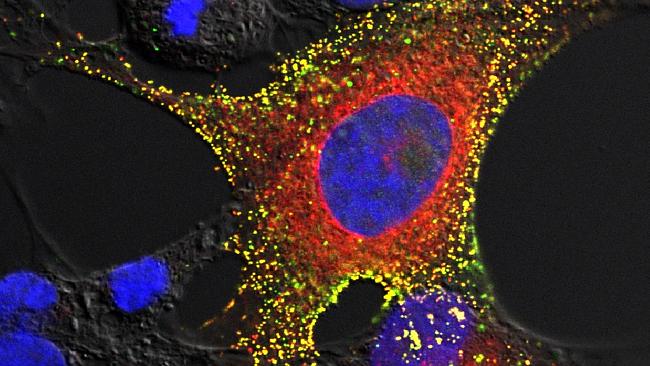
Bat cells containing the Hendra virus — containing it is vital to Australia’s future. Picture: CSIRO Source: Supplied
A PANDEMIC, a potential biosecurity attack and a virus which has the potential to wipe out our food supplies.
These are just some of the things which could wreak havoc across the country’s ecosystem, not only damaging the environment but our very way of life.
A new CSIRO report warns Australia is not immune to global pandemics and viruses and our relative isolation isn’t enough protection against such threats.
The report, Australia’s Biosecurity Future, released today, warns the nation needs to remain on guard against any potential threat and asks how prepared we are to deal with one which may arise.
The report identifies 12 biosecurity ‘megashocks’ which have the potential to become a serious reality including an outbreak of a variant strain of foot and mouth disease, a loss of pollination services as well as an incursion of a new exotic fruit fly.

Think our wheat supplies are safe? An exotic wheat rust could wipe it out unless it remains in check. Source: Supplied
CSIRO Biosecurity Flagship Science Director Gary Fitt warned any of these could become a reality.
Dr Fitt said the report wasn’t aimed to paint a picture of gloom and doom, but rather to prove our biosecurity measures were working and that all Australians had a responsibility to ensure these measures remained in place.
Dr Fitt said while viruses such as Ebola posed a global health concern, it was often the smaller, seemingly less harmful, viruses which posed a bigger threat and could have just as large impact.
“Farmers near Katherine, in the Northern Territory are dealing with an outbreak of a new disease — Cucumber Green Mottle Mosaic Virus and — and while not fatal to people like Ebola, this virus is devastating their crops which has severe financial impacts,” he said.
The report also examines where Australia is heading and what the country needs to do to protect its environment, industries and people over the next 20-30 years.

A virus such as Ebola could wreak havoc across Australia. Source: AFP
As well as identifying 12 potential megashocks, it also identifies global megatrends that highlight significant change and the growing complexity of Australia’s biosecurity challenges.
“We have identified a number of important trends, such as the need to produce more food for a growing population while dealing with ongoing pressure on the key soil, water and biodiversity resources which sustain production,” Dr Fitt said.
He said something seemingly small, such as a declining honey bee population, was just one example of where we needed to remain vigilant.
“If there was a significant decline in European honey bee in the future, for example, this would impact our economy with losses of around $4-6 billion,” Dr Fitt said.
“Losing this free pollination service would severely impact production of several fruit and vegetables including avocados and almonds.”

CSRIO scientists working at the highest level of biosecurity. Picture: CSIRO Source: Supplied
Dr Fitt added understanding the biosecurity megatrends will help Australia prepare for any pest or disease which threatened us.
But Dr Fitt warned these trends also pointed towards a future where existing biosecurity processes and practices might not be enough to protect us.
“We are an island and have had the luxury of isolation,” Dr Fitt told news.com.au.
“But the main point is we belong to a global community and that our isolation is no longer enough of a protection.”
Dr Fitt said another interesting point the report raised was the growing pressure on agriculture and food resources with greater demand for products increasing the risk of disease.
He added social expectations, such as consumers’ demand for free-range eggs, for example, increased the risk of an aviation outbreak since outside birds were exposed to wild birds.
“The important thing is, this isn’t just doom and gloom, it’s just we need to be vigilant,” he said.
“An investment in biosecurity is just that an investment, and not a cost.”

Foot and mouth disease, caused by the Coxsackie virus, has been identified as a megashock. Source: Supplied
The megashocks identified in the report include:
— Nationwide incursion of a new race of an exotic wheat stem rust — one more
virulent than existing races of UG99
— Nationwide loss of pollination services from feral European honey bees due to a
multistate varroa mite incursion
— Nationwide incursion of a new exotic fruit fly
— Nationwide outbreak of a variant strain of foot and mouth disease
— Bluetongue outbreak across Australia’s major sheep producing regions
— Highly virulent rust spreads across multiple ecosystems
— Government ‘walks away’ from environmental biosecurity
— Successful establishment of black-striped mussel
— Outbreak of infectious salmon anaemia
— Nationwide zoonotic disease epidemic

The Cucumber green Mottle Mosaic Virus is another threat. Source: News Corp Australia
Originally published as The 12 tiny things which could wipe us out
